Al
Segars
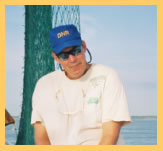 Al
is a veterinarian for the Marine Resources Division at SCDNR. He has
a veterinary degree from UGA and BS in Forestry Recreation
from Clemson University. Al has had a mixed animal practice for 14
years in Hartsville, SC. He
moved to Beaufort, SC for the DNR position and during the summer he
does turtles! He also covers all marine/aquatic animals
(fish kills, marine mammals, etc.). The big turtle focus here is:
where do the juveniles go? He is also involved in the mariculture
industry to help set protocols for shrimp catches and health criteria
for imported seafood. He also helps evaluate and certify aquaculture
farms and hatcheries. Al assists DHEC with West Nile Virus cases as
well. Visit http://www.dnr.state.sc.us/marine/turtles/ for more information
on the SCDNR marine turtle conservation program.
Al
is a veterinarian for the Marine Resources Division at SCDNR. He has
a veterinary degree from UGA and BS in Forestry Recreation
from Clemson University. Al has had a mixed animal practice for 14
years in Hartsville, SC. He
moved to Beaufort, SC for the DNR position and during the summer he
does turtles! He also covers all marine/aquatic animals
(fish kills, marine mammals, etc.). The big turtle focus here is:
where do the juveniles go? He is also involved in the mariculture
industry to help set protocols for shrimp catches and health criteria
for imported seafood. He also helps evaluate and certify aquaculture
farms and hatcheries. Al assists DHEC with West Nile Virus cases as
well. Visit http://www.dnr.state.sc.us/marine/turtles/ for more information
on the SCDNR marine turtle conservation program.
Ian
Moody
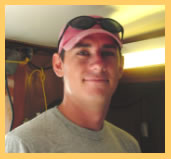 Ian is a DNR Biologist, Level I. He received a B.S. in marine science
from the College of Charleston. His main area of expertise
is in algal toxicology. Ian has also been working with SEAMAP, a 20
year program utilizing 100 stations between cape Hatteras and Cape
Canaveral within 3 miles of shore. Sample sites are randomly selected
three times per year. Ian interned for SCDNR and has also participated
in the SEA program at Woods Hole Oceanographic Institute.
Ian is a DNR Biologist, Level I. He received a B.S. in marine science
from the College of Charleston. His main area of expertise
is in algal toxicology. Ian has also been working with SEAMAP, a 20
year program utilizing 100 stations between cape Hatteras and Cape
Canaveral within 3 miles of shore. Sample sites are randomly selected
three times per year. Ian interned for SCDNR and has also participated
in the SEA program at Woods Hole Oceanographic Institute.
Heather
Chadwick
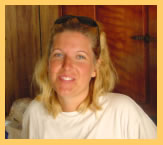 Heather
is a 3rd year veterinary student at North Carolina State University
with an undergraduate degree in Biology. She is currently participating
in an internship with SCDNR. She does the labeling and measurements
for each turtle surveyed. Previously, Heather was an intern in South
Africa, relocating giraffes, lions and leopards by darting them from
helicopters and relocating them for a breeding program between parks.
She hopes to have a mixed animal practice in a small town. She’s
been surprised at the unique personalities of reptiles
and plans to continue to volunteer with the Topsail Beach sea turtle
hospital in North Carolina - www.seaturtlehospital.org
Heather
is a 3rd year veterinary student at North Carolina State University
with an undergraduate degree in Biology. She is currently participating
in an internship with SCDNR. She does the labeling and measurements
for each turtle surveyed. Previously, Heather was an intern in South
Africa, relocating giraffes, lions and leopards by darting them from
helicopters and relocating them for a breeding program between parks.
She hopes to have a mixed animal practice in a small town. She’s
been surprised at the unique personalities of reptiles
and plans to continue to volunteer with the Topsail Beach sea turtle
hospital in North Carolina - www.seaturtlehospital.org
Michelle
Johnson
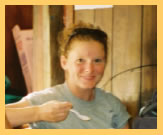 Michelle
is a senior in marine biology at University of North Carolina Wilmington.
She is currently interning for the summer with Pritchard Island’s
sea turtle nesting program (http://www.sc.edu/beaufort/pritchar/piturtle.htm).
She is measuring and PIT tagging nesting females as well as relocating
nests when necessary. To date, they have had 42 nests and 80 false
crawls (1/3 way through nesting season). This season is the first
time a tagged turtle has returned to Pritchard’s. She was tagged
2 years ago which is unusual because it was thought that turtles nested
every 3rd year. Michelle has always wanted to be a marine biologist
and has been working at the Topsail Beach sea turtle hospital in North
Carolina (www.seaturtlehospital.org).
She’s thinking about going to veterinary school.
Michelle
is a senior in marine biology at University of North Carolina Wilmington.
She is currently interning for the summer with Pritchard Island’s
sea turtle nesting program (http://www.sc.edu/beaufort/pritchar/piturtle.htm).
She is measuring and PIT tagging nesting females as well as relocating
nests when necessary. To date, they have had 42 nests and 80 false
crawls (1/3 way through nesting season). This season is the first
time a tagged turtle has returned to Pritchard’s. She was tagged
2 years ago which is unusual because it was thought that turtles nested
every 3rd year. Michelle has always wanted to be a marine biologist
and has been working at the Topsail Beach sea turtle hospital in North
Carolina (www.seaturtlehospital.org).
She’s thinking about going to veterinary school.
Captain Bubba Daniels
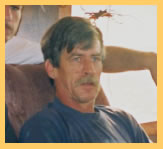 Captain
Bubba has been on shrimp boats since he was 4 or 5 years
old with his father. At age 17 he was running his own boat
and is a 4th generation shrimper. He’s also worked on research
and tow vessels, but always came back to shrimping. His shrimping
business has been prosperous and he owns his own boat. He was contracted
to trawl for the DNR Turtle project. He says the work breaks up the
monotony of shrimping and is more guaranteed than the amount
of shrimp he might catch. The hours are what he likes least about
shrimping: almost 24 hr days for 5 or 6 day stretches. Shrimping technology
hurts more than it helps in his opinion because it allows
more people to have access to the fish and shrimp rather than learning
the compass and bathymetry skills.
Captain
Bubba has been on shrimp boats since he was 4 or 5 years
old with his father. At age 17 he was running his own boat
and is a 4th generation shrimper. He’s also worked on research
and tow vessels, but always came back to shrimping. His shrimping
business has been prosperous and he owns his own boat. He was contracted
to trawl for the DNR Turtle project. He says the work breaks up the
monotony of shrimping and is more guaranteed than the amount
of shrimp he might catch. The hours are what he likes least about
shrimping: almost 24 hr days for 5 or 6 day stretches. Shrimping technology
hurts more than it helps in his opinion because it allows
more people to have access to the fish and shrimp rather than learning
the compass and bathymetry skills.
Earl O'Neal
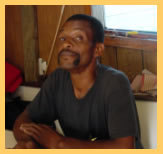 Earl
is a deckhand and cook for the shrimp trawler Miss Tina. Some of his
duties include shopping for groceries, cleaning, making repairs to
the boat and handling the shrimp nets. He’s been doing this
since he was 17 years old (he’s 51 now). He got hooked when
he went out shrimping with a friend in high school for Thanksgiving
Break. He loves the job because of the great pay and the opportunity
to travel. One thing he doesn’t like is rough seas. He remembers
a particular storm with 18 foot seas that lasted about 12 hours. He’s
disappointed in the prices that shrimp are getting now because of
all the shrimp that’s being imported.
Earl
is a deckhand and cook for the shrimp trawler Miss Tina. Some of his
duties include shopping for groceries, cleaning, making repairs to
the boat and handling the shrimp nets. He’s been doing this
since he was 17 years old (he’s 51 now). He got hooked when
he went out shrimping with a friend in high school for Thanksgiving
Break. He loves the job because of the great pay and the opportunity
to travel. One thing he doesn’t like is rough seas. He remembers
a particular storm with 18 foot seas that lasted about 12 hours. He’s
disappointed in the prices that shrimp are getting now because of
all the shrimp that’s being imported.
Gerald
Duncan
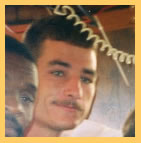 Gerald
has been a deckhand for about 8 years. Shrimping has been a family
business and he’s stuck with it. He enjoys the peace and quiet
that allows him to think. He doesn’t plan on doing anything
else. He’s responsible for the rigs, setting up, picking the
shrimp and sometimes driving the boat. He says one of the downfalls
of his job is the minimal money available in the winter months.
Gerald
has been a deckhand for about 8 years. Shrimping has been a family
business and he’s stuck with it. He enjoys the peace and quiet
that allows him to think. He doesn’t plan on doing anything
else. He’s responsible for the rigs, setting up, picking the
shrimp and sometimes driving the boat. He says one of the downfalls
of his job is the minimal money available in the winter months.